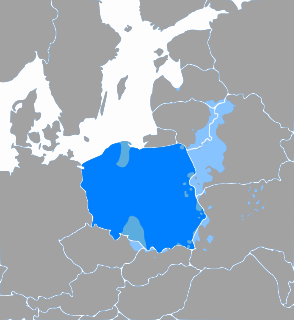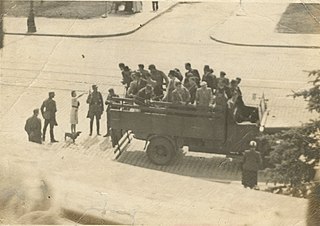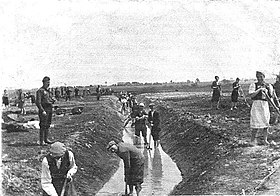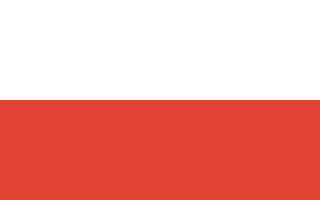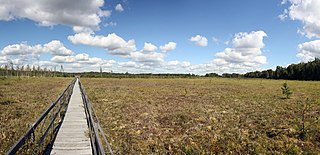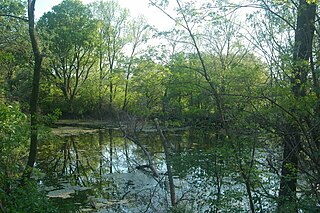
Sobibor was a Nazi German extermination camp built and operated by the SS during World War II near the railway station of Sobibór near Włodawa within the semi-colonial territory of General Government of the occupied Second Polish Republic.

Lublin Voivodeship, or Lublin Province, is a voivodeship, or province, located in southeastern Poland. It was created on January 1, 1999, out of the former Lublin, Chełm, Zamość, Biała Podlaska and (partially) Tarnobrzeg and Siedlce Voivodeships, pursuant to Polish local government reforms adopted in 1998. The province is named after its largest city and regional capital, Lublin, and its territory is made of four historical lands: the western part of the voivodeship, with Lublin itself, belongs to Lesser Poland, the eastern part of Lublin Area belongs to Red Ruthenia, and the northeast belongs to Polesie and Podlasie.

Sobibór is a village in the administrative district of Gmina Włodawa, within Włodawa County, Lublin Voivodeship, in eastern Poland. It lies close to the Bug River, which forms the border with Belarus and Ukraine.

Końskowolapronounced [kɔɲskɔˈvɔla] is a village in southeastern Poland, located between Puławy and Lublin, near Kurów on the Kurówka River. It is the seat of a separate commune (gmina) within Puławy County in Lublin Voivodeship, called Gmina Końskowola; population: 2,188 inhabitants.

Izbicapronounced ['izˈbit͡sa] is a village in the Krasnystaw County of the Lublin Voivodeship in eastern Poland. It is the seat of the gmina administrative district called Gmina Izbica. It lies approximately 13 kilometres (8 mi) south of Krasnystaw and 59 km (37 mi) south-east of the regional capital Lublin. It has a population of 1,933.
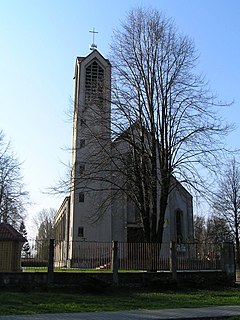
Trawniki is a village in Świdnik County, Lublin Voivodeship, in eastern Poland. It is the seat of the gmina called Gmina Trawniki. It lies approximately 24 kilometres (15 mi) south-east of Świdnik and 33 km (21 mi) south-east of the regional capital Lublin.

The Parczew partisans were fighters in irregular military groups participating in the Jewish resistance movement against Nazi Germany and its collaborators during World War II. The name of the partisan force, coined by the Holocaust historians, is borrowed from the Parczew forest located a short distance away from Lublin, halfway to the town of Sobibór, the location of the Sobibór extermination camp during the Holocaust in occupied Poland. The Jews who managed to escape from the camp hid in there along with the considerable number of Jewish families of the Lublin Ghetto.
Gmina Włodawa is a rural gmina in Włodawa County, Lublin Voivodeship, in eastern Poland, on the border with Belarus and Ukraine. Its seat is the town of Włodawa, although the town is not part of the territory of the gmina.

Świerże is a village in the administrative district of Gmina Dorohusk, within Chełm County, Lublin Voivodeship, in eastern Poland, close to the border with Ukraine. It lies approximately 9 kilometres (6 mi) north-west of Dorohusk, 19 km (12 mi) north-east of Chełm, and 82 km (51 mi) east of the regional capital Lublin.

Dubienka is a village in Chełm County, Lublin Voivodeship, in eastern Poland, close to the border with Ukraine on the Bug River. It is the seat of the gmina called Gmina Dubienka. It lies approximately 31 kilometres (19 mi) east of Chełm and 95 km (59 mi) east of the regional capital Lublin.

Skryhiczyn is a village in the administrative district of Gmina Dubienka, within Chełm County, Lublin Voivodeship, in eastern Poland, close to the border with Ukraine. It lies approximately 9 kilometres (6 mi) south-east of Dubienka, 37 km (23 mi) south-east of Chełm, and 100 km (62 mi) east of the regional capital Lublin.

Siedliszcze is a town in Chełm County, Lublin Voivodeship, in eastern Poland. It is the seat of the gmina called Gmina Siedliszcze. It lies approximately 23 kilometres (14 mi) west of Chełm and 42 km (26 mi) east of the regional capital Lublin.

Sawin is a settlement in Chełm County, Lublin Voivodeship, in eastern Poland. It is the seat of the gmina called Gmina Sawin. It lies approximately 14 kilometres (9 mi) north of Chełm and 61 km (38 mi) east of the regional capital Lublin.

Dorohucza is a village in the administrative district of Gmina Trawniki, within Świdnik County, Lublin Voivodeship, in eastern Poland. It lies approximately 23 kilometres (14 mi) east of Świdnik and 33 km (21 mi) east of the regional capital Lublin. The village has a population of 753.
Hańsk-Kolonia is a village in the administrative district of Gmina Hańsk, within Włodawa County, Lublin Voivodeship, in eastern Poland.

Adampol is a village in the administrative district of Gmina Wyryki, within Włodawa County, Lublin Voivodeship, in eastern Poland.

Grabowiec is a village in Zamość County, Lublin Voivodeship, in eastern Poland. It is the seat of the gmina called Gmina Grabowiec. It lies approximately 24 kilometres (15 mi) north-east of Zamość and 84 km (52 mi) south-east of the regional capital Lublin.

Kowale Pańskie is a village in the administrative district of Gmina Kawęczyn, within Turek County, Greater Poland Voivodeship, in west-central Poland. It lies approximately 4 kilometres (2 mi) north of Kawęczyn, 10 km (6 mi) south of Turek, and 122 km (76 mi) south-east of the regional capital Poznań.

The Sobibór Museum or the Museum of the Former Sobibór Nazi Death Camp, is a Polish state-owned museum devoted to remembering the atrocities committed at the former Sobibor extermination camp located on the outskirts of Sobibór near Lublin. The Nazi German death camp was set up in occupied Poland during World War II, as part of the Jewish extermination program known as the Operation Reinhard, which marked the most deadly phase of the Holocaust in Poland. The camp was run by the SS Sonderkommando Sobibor headed by Franz Stangl. The number of Jews from Poland and elsewhere who were gassed and cremated there between April 1942 and October 14, 1943 is estimated at 250,000; possibly more, including those who came from other Reich-occupied countries.

